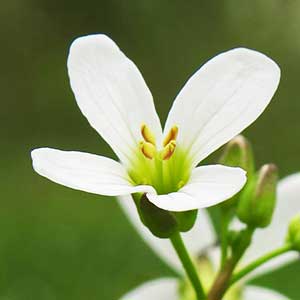Cardamine flagellifera
Cardamine penduliflora
Blue Ridge bittercress
wetlands bitter-cress, Willamette Valley bitter-cress
swollen, compact at stem base, (fleshy, stolons many, slender, ca. 1 mm diam., pubescent or glabrous).
(tuberiform, fragile), 4–9(–11) mm diam., (fleshy).
erect, usually unbranched, rarely branched distally, 1–2.5 dm, sparsely to densely hirsute or pilose proximally, sparsely so or glabrous distally.
erect or decumbent at base, unbranched, 2–6(–7.5) dm.
usually simple, rarely 3-foliolate, (3–)6–16 cm, leaflets petiolulate or subsessile;
petiole (1.5–)4–13 cm;
lateral leaflets subsessile or petiolulate (to 0.5 cm), blade similar to terminal, much smaller;
terminal leaflet (petiolule 0.5–2 cm), blade orbicular to reniform or broadly ovate, (1–)1.5–4.5 cm, base cordate, margins repand to coarsely crenate, (apiculate at vein endings, surfaces sparsely pubescent or glabrous).
5–13-foliolate, (4–)10–18(–25) cm, leaflets petiolulate or subsessile;
petiole (3–)5–12(–17) cm;
lateral leaflets subsessile, blade similar to terminal, sometimes smaller;
terminal leaflet (petiolule 0.4–0.7 cm), blade oblong to elliptic or ovate, (0.4–)0.7–1.7(–2) cm, base cuneate or obtuse, margins entire or obscurely 3-lobed.
2–5, 3 or 5-foliolate, petiolate, leaflets petiolulate or subsessile;
petiole 0.8–5 cm, base not auriculate;
lateral leaflets sessile or petiolulate (to 0.5 cm), blade similar to terminal, smaller;
terminal leaflet petiolulate (0.5–1.5 cm), blade broadly ovate to suborbicular, 1.5–4(–5) cm × 12–35 mm, margins repand to coarsely crenate or slightly lobed, (apiculate at vein endings, margins glabrous).
2–6, 5–11-foliolate, petiolate, leaflets petiolulate or sessile;
petiole 3–10 cm, base not auriculate;
lateral leaflets sessile, blade similar to terminal, smaller;
terminal leaflet (petiolule 0.5–1.5 cm), blade narrowly ovate or oblong to oblanceolate, 1.5–3.5 cm × 2–15 mm, margins entire or toothed to 3-lobed.
ebracteate.
ebracteate.
sepals (ascending) oblong, 3–3.5 × 1–1.5 mm, lateral pair not saccate basally;
petals white, oblanceolate, 5–6.5(–8) × 1.5–2.5 mm, (not clawed, apex obtuse to subemarginate);
filaments: median pairs 3.5–5 mm, lateral pair 2.5–3 mm;
anthers oblong, 1.2–1.6 mm.
sepals oblong to ovate, 3.5–5 × 1.8–2.5 mm, lateral pair saccate basally;
petals white, obovate, 12–16 × 6–8 mm, (not clawed, apex rounded or subemarginate);
filaments: median pairs 6–7 mm, lateral pair 4–5 mm;
anthers oblong, 1.5–1.8 mm.
ascending to divaricate-ascending, 7–20 mm.
ascending to divaricate, (10–)20–40(–60) mm.
linear, 1.5–2.5 cm × 1–1.2 mm;
ovules 10–14 per ovary;
style 1.2–2.5 mm.
linear, 2.5–4.5 cm × 1.4–2 mm;
ovules 12–24 per ovary;
style 4–6 mm.
brown, oblong, 1.2–1.7 × 0.8–1.1 mm.
brown, oblong, 1.8–2 × 1–1.5 mm.
Cardamine flagellifera
Cardamine penduliflora
Cardamine penduliflora is known from Douglas County north into Benton, Lane, Marion, Polk, and Yamhill counties.
(Discussion copyrighted by Flora of North America; reprinted with permission.)
